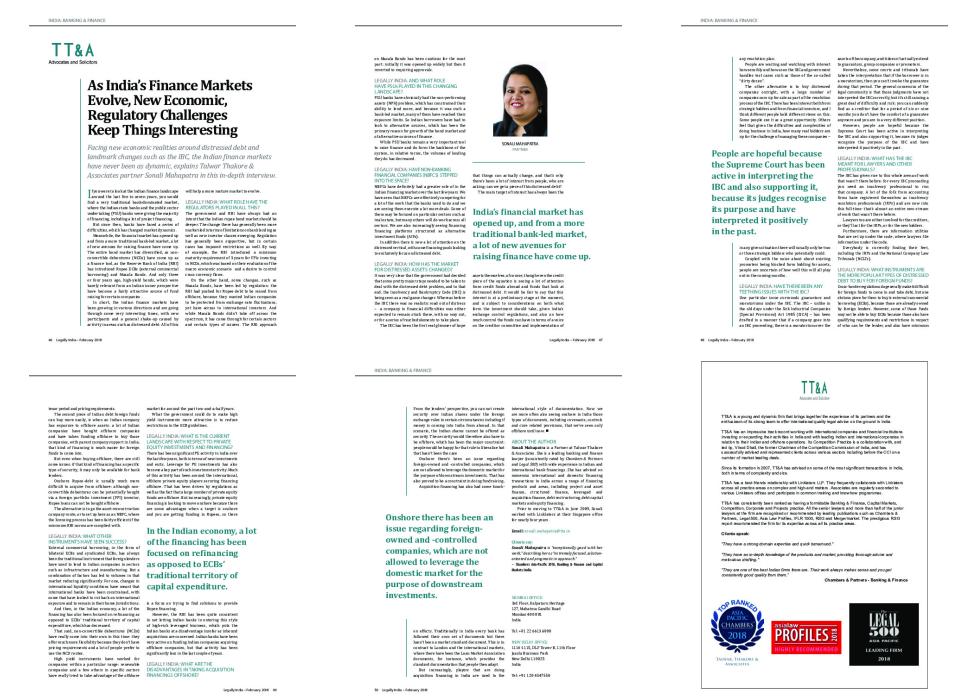If you were to look at the Indian finance landscape around the last five to seven years, you would find a very traditional bank-dominated market, where the Indian state banks and the public sector undertaking (PSU) banks were giving the majority of financing, including a lot of project financing.
But since then, banks have faced a series of difficulties, which has changed market dynamics.
Meanwhile, the financial market has opened up and from a more traditional bank-led market, a lot of new avenues for raising finance have come up. The entire bond market has diversified, as non-convertible debentures (NCDs) have come up as a finance tool, as the Reserve Bank of India (RBI) has introduced Rupee ECBs (external commercial borrowing) and Masala Bonds. And only three or four years ago, high-yield bonds, which were barely relevant from an Indian issuer perspective have become a fairly attractive source of fund raising for certain companies.
In short, the Indian finance markets have been growing in various directions and are going through some very interesting times, with new participants and a general shake-up caused by activity in areas such as distressed debt. All of this will help a more mature market to evolve.
What role have the regulators played in all this?
The government and RBI have always had an intent that the Indian rupee bond market should be deeper. The change there has generally been more market-led in terms of limitations on bank lending as well as new investor classes emerging. Regulation has generally been supportive, but in certain cases has imposed restrictions as well. By way of example, the RBI introduced a minimum maturity requirement of 3 years for FPIs investing in NCDs, which was based on their evaluation of the macro economic scenario and a desire to control cross currency flows.
On the other hand, some changes, such as Masala Bonds, have been led by regulation: the RBI had pushed for Rupee debt to be raised from offshore, because they wanted Indian companies to be protected from exchange rate fluctuations, yet have access to international investors. And while Masala Bonds didn’t take off across the spectrum, it has come through for certain sectors and certain types of issuers. The RBI approach on Masala Bonds has been cautious for the most part: initially it was opened up widely but then it reverted to requiring approvals.
And what role have PSUs played in this changing landscape?
PSU banks have obviously had the non-performing assets (NPA) problem, which has constrained their ability to lend more, and because it was such a bank-led market, many of them have reached their exposure limits. So Indian borrowers have had to look to alternative sources, which has been the primary reason for growth of the bond market and of alternative sources of finance.
While PSU banks remain a very important tool to raise finance and do form the backbone of the system, in relative terms, the volumes of lending they do has decreased.
Have non-banking financial companies (NBFCs) stepped into the space?
NBFCs have definitely had a greater role of in the Indian financing market over the last few years. We have seen that NBFCs are effectively competing for a lot of the work that the banks used to do and we are seeing them execute a lot more deals. Some of them may be focused on particular sectors such as real estate, but many others will do work across all sectors. We are also increasingly seeing financing financing platforms structured as alternative investment funds (AIFs).
In addition there is now a lot of attention on the distressed vertical, with some financing pools looking to exclusively focus on distressed debt.
How has the market for distressed assets changed?
It was very clear that the government had decided that some pretty major steps needed to be taken to deal with the distressed debt problem, and to that end, the Insolvency and Bankruptcy Code (IBC) is being seen as a real game changer. Whereas before the IBC there was no realistic road out of distress – a company in financial difficulties was either expected to remain stuck there, with no way out, or for a series of reschedulements to take place.
The IBC has been the first real glimmer of hope that things can actually change, and that’s why there’s been a lot of interest from people, who are asking: can we get a piece of this distressed debt?
The main target of interest has always been the assets themselves, of course, though even the credit piece of the equation is seeing a lot of attention from credit funds abroad and funds that look at distressed debt. It would be fair to say that this interest is at a preliminary stage at the moment, and is subject to considerations on both what form the investment should take, given India’s exchange control regulations, and also on how much control the funds can have in terms of a voice on the creditor committee and implementation of any resolution plan.
People are waiting and watching with interest how sensibly and how soon the IBC and government handles test cases such as those of the so-called “dirty dozen”.
The other alternative is to buy distressed companies outright, with a large number of companies now up for sale as part of the resolution process of the IBC. There has been interest both from strategic bidders and from financial investors, and I think different people hold different views on this. Some people see it as a great opportunity. Others feel that given the difficulties and complexities of doing business in India, how many real bidders are up for the challenge of managing these companies – in any given situation there will usually only be two or three strategic bidders who potentially could.
Coupled with the noise about about existing promoters being blocked form bidding for assets, people are uncertain of how well this will all play out in the coming months.
Have there been any teething issues with the IBC?
One particular issue surrounds guarantors and moratoriums under the IBC. The IBC – unlike in the old days under the Sick Industrial Companies (Special Provisions) Act 1985 (SICA) – has been drafted in a manner that if a company goes into an IBC proceeding, there is a moratorium over the assets of the company, and it doesn’t actually extend to guarantors, group companies or promoters.
Nevertheless, some courts and tribunals have taken the interpretation that if the borrower is in a moratorium, then you can’t invoke the guarantee during that period. The general consensus of the legal community is that those judgments have not interpreted the IBC correctly, but it’s still causing a great deal of difficulty and risk: you can suddenly find as a creditor that for a period of six or nine months you don’t have the comfort of a guarantee anymore and you are in a very different position.
However, people are hopeful because the Supreme Court has been active in interpreting the IBC and also supporting it, because its judges recognise the purpose of the IBC and have interpreted it positively in the past.
What has the IBC meant for lawyers and other professionals?
The IBC has given rise to this whole arena of work that wasn’t there before: for every IBC proceeding you need an insolvency professional to run that company. A lot of the folk from accounting firms have registered themselves as insolvency resolution professionals (IRPs) and are now into this full-time: that’s almost an entire new stream of work that wasn’t there before.
Lawyers too are either involved for the creditors, or they’ll act for the IRPs, or for the new bidders.
Furthermore, there are information utilities that are set up under the code, where lawyers file information under the code.
Everybody is currently finding their feet, including the IRPs and the National Company Law Tribunals (NCLTs).
What instruments are the more popular types of distressed debt to buy for foreign funds?
Cross-border regulations do generally make it difficult for foreign funds to come in and take debt, but one obvious piece for them to buy is external commercial borrowing (ECBs), because those are already owned by foreign lenders. However, some of those funds may not be able to buy ECBs because those also have qualifying requirements and restrictions in respect of who can be the lender, and also have minimum tenor period and pricing requirements.
The second piece of Indian debt foreign funds can buy more easily, is when an Indian company has exposure to offshore assets: a lot of Indian companies have bought offshore companies and have taken funding offshore to buy those companies, with parent company support in India; that kind of financing is much easier for foreign funds to come into.
But even when buying offshore, there are still some issues: if that kind of financing has a specific type of security, it may only be available for bank lenders.
Onshore Rupee-debt is usually much more difficult to acquire from offshore: although non-convertible debentures can be potentially bought via a foreign portfolio investment (FPI) investor, Rupee loans can not be bought offshore.
The alternative is to go the asset reconstruction company route, or to set up here as an NBFC, where the licensing process has been fairly efficient if the minimum RBI norms are complied with.
What other instruments have seen success?
External commercial borrowing, in the form of bilateral ECBs and syndicated ECBs, has always been the traditional instrument that foreign lenders have used to lend to Indian companies in sectors such as infrastructure and manufacturing. But a combination of factors has led to volumes in that market reducing significantly. For one, changes in international liquidity conditions have meant that international banks have been constrained, with some that have looked to cut back on international exposure and to remain in their home jurisdictions.
And then, in the Indian economy, a lot of the financing has also been focused on refinancing as opposed to ECBs’ traditional territory of capital expenditure, which has decreased.
That said, non-convertible debentures (NCDs) have really come into their own in this time: they offer much more flexibility because they don’t have pricing requirements and a lot of people prefer to use the NCD routes.
High yield instruments have worked for companies within a particular range: renewable companies and a few others in specific sectors have really tried to take advantage of the offshore market for around the past two-and-a-half years.
What the government could do to make high yield instruments more attractive is to reduce restrictions in the ECB guidelines.
What is the current landscape with respect to private equity investments and financing?
There has been significant PE activity in India over the last few years, both in terms of new investments and exits. Leverage for PE investments has also become a key part of such investment activity. Much of this activity has been around the international, offshore private equity players securing financing offshore. That has been driven by regulations as well as the fact that a large number of private equity funds are offshore. But increasingly, private equity financing is looking to move onshore because there are some advantages when a target is onshore and you are getting funding in Rupees, so there is a focus on trying to find solutions to provide Rupee financing.
However, the RBI has been quite consistent in not letting Indian banks in entering this style of high-risk leveraged business, which puts the Indian banks at a disadvantage insofar as inbound acquisitions are concerned. Indian banks have been very active on funding Indian companies acquiring offfshore companies, but that activity has been significantly less in the last couple of years.
What are the disadvantages in taking acquisition financings offshore?
From the lenders’ perspective, you can not create security over Indian shares under the foreign exchange rules in certain circumstances including if money is coming into India from abroad. In that scenario, the Indian shares cannot be offered as security. The security would therefore also have to be offshore, which has been the major constraint: people would be happy for that rule to liberalise but that hasn’t been the case
Onshore there’s been an issue regarding foreign-owned and -controlled companies, which are not allowed to leverage the domestic market for the purpose of downstream investments. That has also proved to be a constraint in doing fundraising.
Acquisition financing has also had some knock-on effects. Traditionally in India every bank has followed their own set of documents but there hasn’t been a market standard document. This is in contrast to London and the international markets, where there have been the Loan Market Association documents, for instance, which provides the standard documentation that people then adapt.
But increasingly, players that are doing acquisition financing in India are used to the international style of documentation. Now we are more often also seeing onshore in India those types of documents, including covenants, controls and cure related provisions, that we’ve seen only offshore until now.
ABOUT THE AUTHOR

Sonali Mahapatra is a Partner at Talwar Thakore & Associates. She is a leading banking and finance lawyer (consistently rated by Chambers & Partners and Legal 500) with wide experience in Indian and international bank financings. She has advised on numerous international and domestic financing transactions in India across a range of financing products and areas, including project and asset finance, structured finance, leveraged and acquisition finance, debt restructuring, debt capital markets and equity financing.
Prior to moving to TT&A in June 2009, Sonali worked with Linklaters at their Singapore office for nearly four years.
Clients say:
Sonali Mahapatra is “exceptionally good with her work,” describing her as “extremely focused, solution-oriented and pragmatic in approach.”
– Chambers Asia-Pacific 2018, Banking & Finance and Capital Markets: India
MUMBAI OFFICE
3rd Floor, Kalpataru Heritage
127, Mahatma Gandhi Road
Mumbai 400 001
India
Tel: +91 22 6613 6900
NEW DELHI OFFICE
1114-1115, DLF Tower B, 11th Floor
Jasola Business Park
New Delhi 110025
India
Tel: +91 120 4547550


Welcome Legally India's Spring 2018 Issue
If you would like to receive future editions, please click here to register your interest.
Our Spring 2018 print and digital edition of Legally India, a joint publication by Global Legal Media and Legally India, has a strong disputes flavour, and examines: AI, global litigation risk, GC wishlists and more than a dozen jurisdictions and practice areas.
